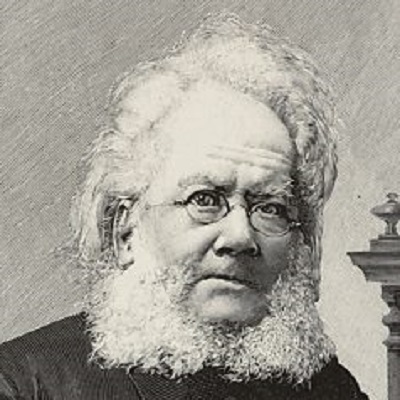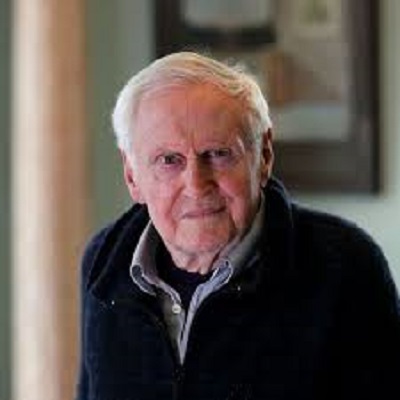Henrik Ibsen- Biography
Page Contents
Henrik Ibsen, a well-known Norwegian playwright, theater director, and poet, is often regarded as the father of modern theater and one of the creators of Modernism in the theater. Ibsen is widely regarded as one of the best playwrights in European literature, and possibly the greatest since Shakespeare. He was born into one of the area’s most important families in Skien, a small port town in Norway. They were incredibly wealthy at first, but his father’s bankruptcy forced them to abandon their gorgeous home and become social outcasts when he was eight years old. He quickly became secretive and melancholy; he struggled in school and was relieved to leave his hometown at the age of sixteen.
After six years of working at a pharmacy, he relocated to Oslo and pursued writing as a vocation. He first encountered success at the age of 36, and after earning a traveling scholarship, he departed his native land. Ibsen spent much of his time in Italy and Germany, where he penned several masterpieces such as ‘Brand,’ ‘Peer Gynt,’ ‘An Enemy of the People,’ ‘Emperor and Galilean,’ ‘A Doll’s House,’ ‘The Wild Duck,’ and so on. He returned to Norway at the age of 63, after 27 years of self-imposed exile, and continued to write until a stroke rendered him handicapped at the age of 72.
Henrik Ibsen- Birth, Age, Ethnicity, Siblings, Education
Henrik Johan Ibsen was born on March 20, 1828, in Skien, a tiny coastal town in Telemark county, Norway, known for its timber trade. Knud Ibsen and Marichen Cornelia Martine nee Altenburg, his parents, were both from notable families in the area. Henrik was the second of his parents’ six children to be born. However, due to the untimely death of his elder brother, Johan Altenburg, he was considered the eldest. He has three brothers, Johan Andreas, Nicolai Alexander, and Ole Paus, as well as one sister, Hedvig.
Knud Ibsen began his career as a prosperous merchant. He lived in a splendid mansion in the middle of town known as Stockmannsgarden (Stockmann House) and had a rich lifestyle, providing hospitality to everybody. Everything changed in 1835 when he lost his money.
In 1836, the family sold Stockmannsgarden and relocated to Venstp, a small and decaying farmhouse on the outskirts of Skien. They later returned to the city, it is unknown when and lived in a house owned by Knud’s half-brother Christopher Blom Paus in Snipetorp.
Knud Ibsen, bankrupt and declassed, resorted to drunkenness, venting his rage on his family. His wife, a lovely lady, bore his misfortune with no resentment or anger. Henrik, an eight-year-old boy, was also deeply affected by the shift in fortune, especially when he noticed that others who had previously taken advantage of their generosity were now avoiding them. He gradually began to live a life of moral solitude, becoming depressed and unsociable.
Perhaps to escape conversation, young Ibsen used to lock himself up in the attic or a small room at the house’s back entrance, reading ancient books or painting. His parents and siblings never understood him. He attended a modest middle-class school run by a man named Johan Hansen while residing in Venstp. Ibsen was taught Latin, German, and religion here. He was a middling student who did not excel in any subject. He did, however, develop a talent for painting.
Ibsen was confirmed and removed from school in 1843, at the age of fifteen, in accordance with Norwegian tradition. He aspired to be a painter, but because it required going abroad for training, which the family couldn’t afford owing to their financial situation, he was turned down.
Henrik Ibsen- Relationship, Married Life
In 1846, while residing in Grimstad, Henrik Ibsen began a relationship with his employer’s maid, Else Sophie Jensdatter Birkedalen, with whom he fathered a son named Hans Jacob Hendricksen Birkdale. He paid for the boy’s upbringing until he was fourteen years old, despite the fact that he did not legalize the relationship.
He married Suzannah Thoresen on June 18, 1858. Sigurd Ibsen, their only son, went up to become a distinguished lawyer and statesman, playing a key role in the collapse of the Norway-Sweden union in 1905. He also wrote a lot of books. Henrik Ibsen experienced his first stroke in March 1900, rendering him unable to write. Following that, he experienced a series of strokes and died on May 23, 1906, at his home in Kristiana. He was later buried in the city center in Vr Frelsers Granlund.
Leaving the House
Ibsen stayed at home for a few months after graduating from high school. He left home for good in 1844, shortly before his sixteenth birthday, and moved to the southeastern portion of Norway. In the little village of Grimstad, he became an apprentice to a pharmacist named Mann.
He moved to Grimstad for the next six years, relieved to be able to escape Skien. He was lonely for the first three years of his existence, too shy to make friends, and too poor to find entertainment. The town’s residents shunned him as well, thinking him odd. To pass the time, he began to read a lot, particularly current poetry. Soon, this remote hamlet, with its old-fashioned Danish charm brought from neighboring Copenhagen, began to have an impact on his creativity. He began dabbling with poetry writing and quickly gathered a group of pals around him.
He composed his first play, ‘Catiline,’ somewhere in 1849. This was also the time when he became interested in a profession in medicine and began preparing for it by studying all night. By 1850, he had collected enough money to travel to Oslo, which was known as Christiana at the time (Kristiania). When he moved to Christiana in 1850, he first enrolled in a coaching school, but he never went on to become a physician. While some biographers believe he failed the entrance examination, others believe he abandoned it soon after attending university, instead of pursuing writing as a career.
In 1850, he had ‘Catiline,’ which he had written the previous year, privately published under the pseudonym Brynjolf Bjarne. However, it had no impact and was rejected by the local theatre. Unwilling to give up, he wrote and published ‘Kjmpehjen’ (The Burial Mound, also known as The Warrior’s Barrow) under the same pseudonym. It drew little attention when it was first produced on September 26, 1850. It did, however, have two more runs.
Increasing Your Knowledge
- After 400 years of Danish dominance, Norway was experiencing a nationalistic awakening at the time. Seeking to resurrect the country’s wonderful heritage and medieval literature, the great violinist Ole Bull wanted to create a Norse theater, Det Norske Theater, in Bergen on Norway’s west coast.
- In 1850, a benefit performance was staged to generate funds for the project. Ibsen delivered a sonnet honoring Norway’s past during this program. Ole Bull was so impressed by it that he hired the twenty-two-year-old Ibsen as the theater poet and stage manager.
In 1851, Ibsen relocated to Bergen to take on his new responsibilities. He was obligated to write one original play each year, in addition to staging plays written by others. Ibsen staged roughly 150 plays until 1858, which helped him gain experience. He gradually grew into a mature playwright. - ‘Sancthansnatten’ (St. John’s Eve, 1852), ‘Fru Inger til steraad’ (Lady Inger of Oestraat, 1854), ‘Gildet paa Solhaug’ (The Feast at Solhaug, 1855), ‘Olaf Liljekrans’ (1856), and ‘Hrmndene paa Helgeland’ (The Vikings at Helgeland, 1858).
- In 1858, he returned to the city, where he joined Kristiania Theatre at a substantially greater pay. He created virtually little while remaining with the establishment until its demise in 1862 and being preoccupied with his duties at the theatre.
- His first important work of this period, ‘Kjrlighedens Komedie’ (Love’s Comedy), was published on December 31, 1862. The press labeled it immoral, igniting a firestorm of anger. Nobody dared to put it on.
- ‘Kongs-Emnerne’ (The Pretender), a play celebrating past Norse heroes, was his only work staged during the Kristiania period. It was written in 1863 and originally performed on January 19, 1864, to a standing ovation. It also earned him a government travel scholarship.
During Exile
- Ibsen travels to Italy on a government scholarship in 1864, bringing his wife and child with him. He spent some time in Rome, where he was captivated by the big old historical buildings. Following that, he moved to Sorrento, a hilltop town facing the Bay of Naples, and made his home there.
- He began to concentrate on writing once he was free of the constraints of Norwegian provincialism, publishing ‘Brand’ in 1865. This verse tragedy about a priest who refuses to give up his ideals premiered on March 24, 1867, in Stockholm, bringing him both fame and money.
- While ‘Brand’ made him popular in Norway, it was his second play, ‘Peer Gynt’ (1867), that made him famous worldwide. It’s largely based on Norwegian folklore garnered him both acclaim and criticism, making him the most controversial dramatist.
- Ibsen moved to Germany in 1868. He began his career in Dresden, where he wrote ‘De unges Forbund’ (The League of Youth) in 1869 and ‘Kejser og Galiler’ (Emperor and Galilean) in 1873. Meanwhile, in 1871, he released ‘Digte,’ an anthology of poetry.
- Ibsen relocated to Munich in 1875, and in October 1875, he began work on one of his most famous works, ‘Samfundets sitter’s (The Pillars of Society), which he finished in the summer of 1877. It was first performed in November and was quickly translated into various languages.
- ‘Et dukkehjem,’ another of his internationally famous works, was published in 1879. It was then renamed ‘A Doll’s House’ in English. It was an instant success when it was first published in Copenhagen on December 4, 1879.
- In 1881, he sparked outrage with ‘Gengangere’ (Ghosts), a story about a man suffering from syphilis as well as In response, he composed ‘En Folkefiende’ (An Enemy of the People, 1882), in which the protagonist has officially proclaimed an enemy of the people for attempting to speak out against contaminated public bathwater.
- In 1884, he completed another significant masterpiece, ‘Vildanden’ (The Wild Duck). It is regarded as one of his finest works; he went on to write ‘Rosmersholm’ (1886), ‘Fruen fra Havet’ (The Lady from the Sea, 1888), and ‘Hedda Gabler’ (1900). (1890).
Return to Home
Henrik Ibsen returned to Norway as a well-known dramatist in 1891. Although he had previously liked to live in seclusion, his situation changed when he established his home in Christiania. He was hailed as a literal hero, and he began to enjoy the limelight, even becoming a tourist attraction.
He continued to work and completed four more significant works before succumbing to a stroke. They were ‘Bygmester Solness’ (1893), ‘Lille Eyolf’ (1894), ‘John Gabriel Borkman’ (1896), and ‘Nr vi dde vaagner’ (1897). (When We Dead Awaken, 1899).
Major Works One of Ibsen’s most popular works is ‘Et dukkehjem’ (A Doll’s House), which was first published on December 21, 1879. It is set in a Norwegian town and deals with the position of a married woman in a male-dominated culture, sparking an extraordinary debate that lasted for a long time. Its first edition of 8,000 copies sold out in less than a month. Following that, its second and third editions were issued on 4 January and 8 March 1880, respectively, and were rapidly sold out. Since then, the play has been adapted numerous times for stage, film, television, and radio.
Achievements & Awards
The King of Norway knighted Henrik Ibsen in 1873, and he was promoted to Commander in 1892.
He was awarded the Grand Cross of the Order of St. Olav in 1893.
Also Read, Chloepowell, Incinders, and Soupachu.





